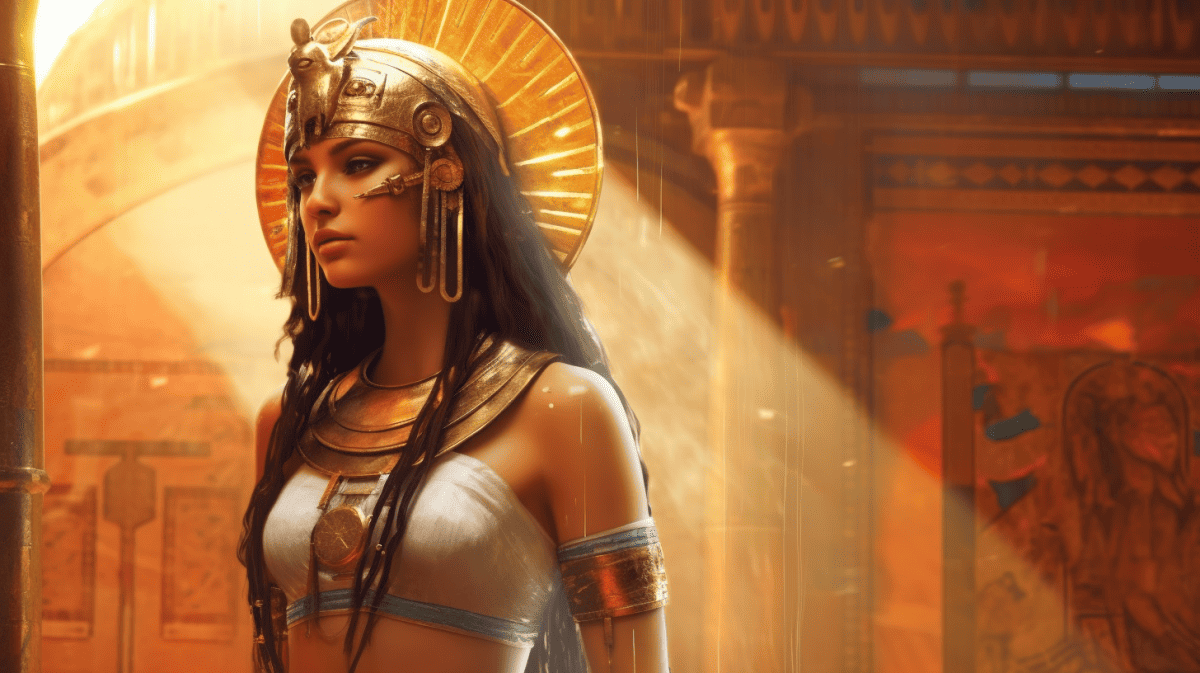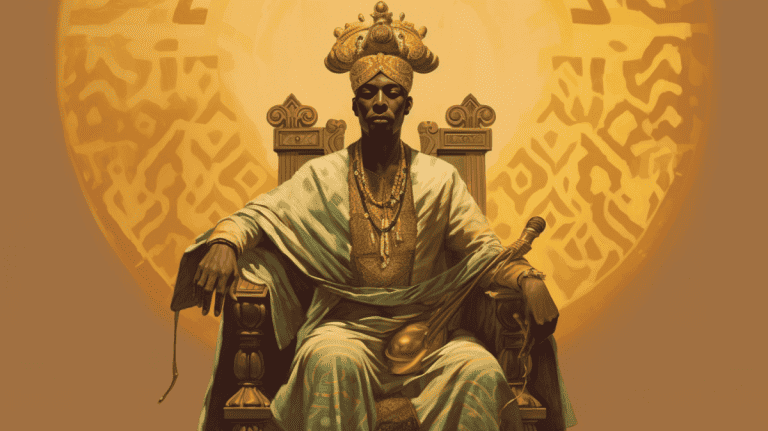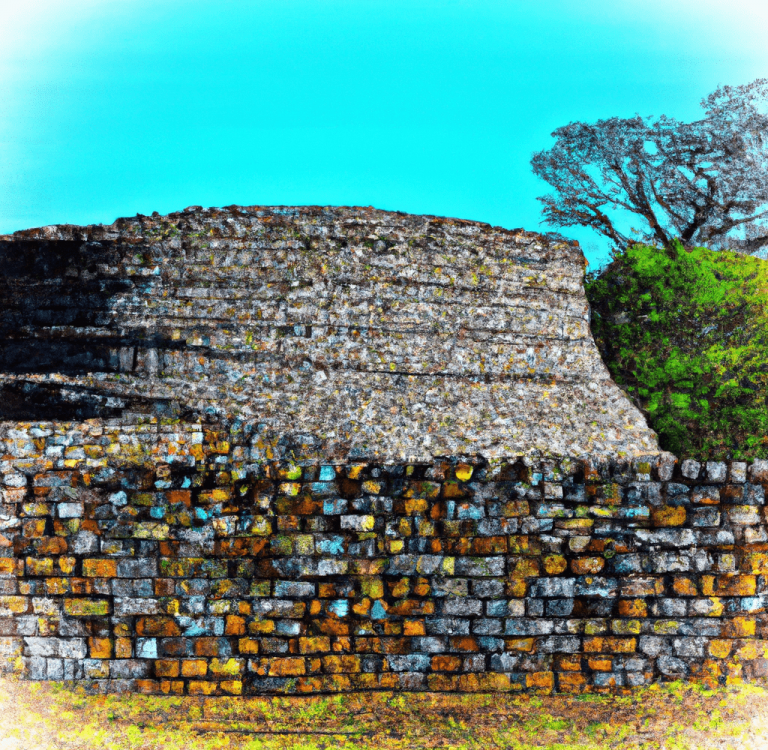Numidia, an ancient Berber kingdom in modern-day Algeria and Tunisia, was founded in the 3rd century BC. Divided into eastern and western regions, it was crucial in the Punic Wars between Carthage and Rome. By the 1st century BC, Rome annexed it, capitalizing on its fertile agriculture.
Initially, the Numidian kingdom was a split realm, fragmented between the eastern Massylii and the western Masaesyli. The battle lines were drawn during the intense period of the Second Punic War, fought between 218–201 BC. During this tempestuous epoch, Masinissa, the valiant ruler of the Massylii, vanquished Syphax of the Masaesyli, orchestrating the unification of Numidia into a single formidable kingdom.
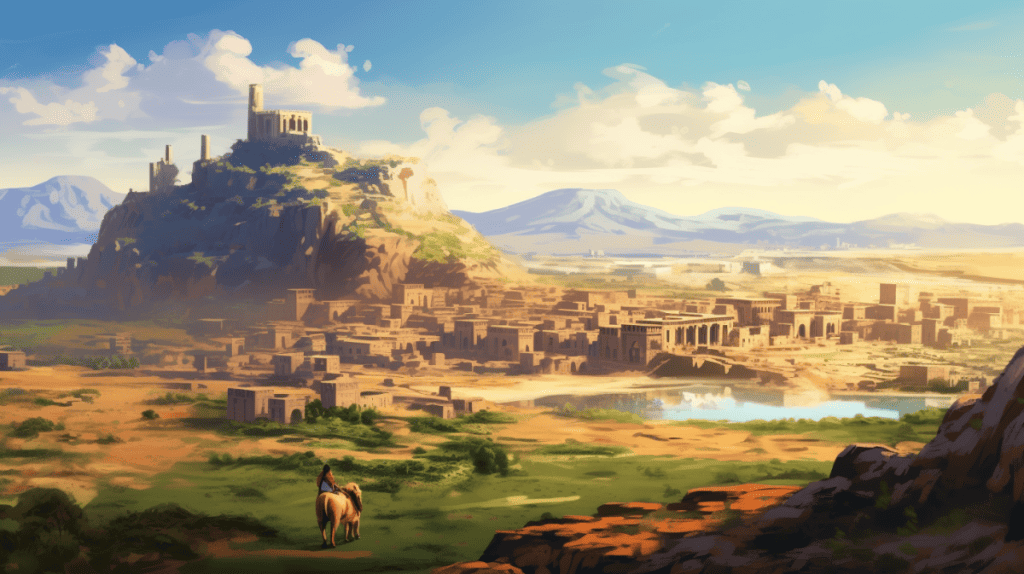
The nascent days of Numidia witnessed it flourishing as an autonomous entity, alternately morphing into a Roman province and a Roman client state in an ever-evolving political landscape.
Numidia’s expansive dominion, at its zenith, stretched from Mauretania in the west, up to the Moulouya River, while sharing its eastern border with Africa Proconsularis. The kingdom was caressed by the azure waters of the Mediterranean Sea to the north and the vast, unforgiving expanse of the Sahara to the south. It stands as one of the foundational cornerstones in the long narrative of Algeria and the Berber civilisation, leaving an indelible mark on the annals of history.
Formation of the Kingdom of Numidia
From the remnants of the primordial Kingdom of Carthage, the Kingdom of Numidia was born. The Numidian populace was splintered into two robust tribal factions – the Massylii holding sway in the East, while the Masaesyli held dominion over the West.

In the violent throes of the Second Punic War, alliances were formed and broken. The Eastern Massylii initially pledged their loyalty to Carthage, while the Western Masaesyli, under the strategic guidance of King Syphax, formed an allegiance with the powerful Roman Empire. Yet, at the turn of the year 206 BC, the winds of change began to blow. The newly enthroned King of the Massylii redirected his allegiance to Rome, prompting Syphax to shift his loyalties towards Carthage.
This decision would eventually be stained with regret as the Romans, in a mighty display of military prowess, seized victory over Carthage. The spoils of this war saw Numidia falling into the hands of the victorious Massylii. Thus, King Masinissa ascended the throne, marking the dawn of a new era as the inaugural King of the Kingdom of Numidia.
History of the Kingdom of Numidia
Once King Masinissa accomplished the monumental task of unifying the disparate regions of the Kingdom of Numidia, he dedicated himself to expanding his realm. His reign, marked by longevity and determination, spanned an astounding 54 years, during which he maintained his vitality up until his passing around the age of 90. He was an active leader, personally leading his troops into battle until his final days. Masinissa’s loyalty to the Roman Empire never wavered, earning him esteemed praise from Polybius, a renowned Greek historian, who lauded him as, “the best man of all the kings of our time.”
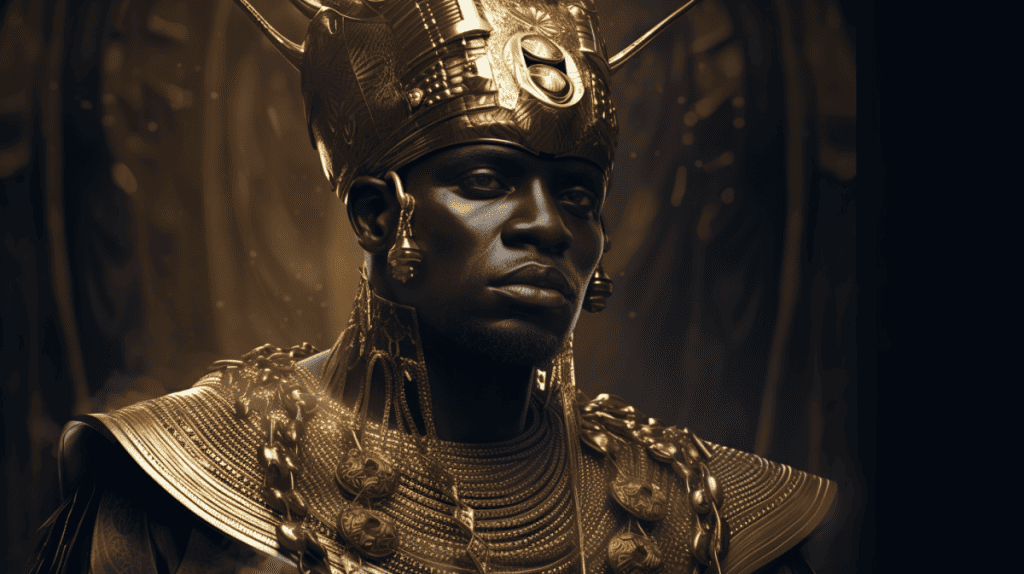
With an ambitious vision of a self-sufficient, robust, and stable nation, King Masinissa introduced the sophisticated agricultural practices of Carthage, encouraging many Numidians to take up the mantle of farming. This transformative move was especially crucial as Numidia had been previously perceived as a region lagging in development. Yet, by the twilight of his reign, Polybius would celebrate Masinissa’s transformative accomplishments by proclaiming, “his greatest and most divine achievement was this: Numidia had been before his time universally unproductive, and was looked upon as incapable of producing any cultivated fruits. He was the first and only man who showed that it could produce cultivated fruits just as well as any other country.”
On the battlefield, King Masinissa was astute, appreciating the importance of fostering strong ties with the Romans while also building a formidable army to safeguard his kingdom against potential threats from Carthage. With the assistance of Rome, he extended his territories and instigated the Third Punic War by assaulting Carthaginian settlements. His robust life ended in 148 BC, just before the conclusion of this war.

Map of Africa Wall Art
Looking to add a little flair to your room or office? Look no further – this wall art of the map of africa has a vivid, fade-resistant print that you’re bound to fall in love with.
His son Micipsa ascended the throne after him, initially taking control of the Kingdom’s Capital and Treasure while his brothers managed the office of Justice and War. However, their premature demise left Micipsa as the sole sovereign. He upheld the alliance with Rome but held lingering doubts, sensing that the Romans were not wholly supportive of the Kingdom of Numidia. Nevertheless, it was under his watchful reign that the threat of Carthage was finally vanquished.
Despite his underlying scepticism about the Romans, Micipsa continued to support them in their military endeavours, bringing modern upgrades to his army in the process.
Sadly, the seeds of the Kingdom of Numidia’s downfall were sown with the fraternal conflict that ensued after Micipsa’s death, eventually leading to the fragmentation of this once great kingdom.
Kings of the Kingdom of Numidia
- Massinissa I (202 BC–148 BC)
- Micipsa (148 BC –118 BC)
- Adherbal (118 BC –112 BC)
- Jugurtha (118 BC –105 BC)
- Gauda (105 BC –88 BC)
- Hiempsal II (88 BC to 60 BC)
- Juda I (60 BC to 46 BC)
Achievements of The Kingdom
Agriculture
In the annals of the Kingdom of Numidia, the advent of agriculture was a beacon of transformation. Once dismissed as a barren wasteland devoid of fertile promise, Numidia rose like a phoenix from the ashes to become Rome’s abundant granary. This metamorphosis, a direct result of implementing advanced agricultural techniques gleaned from Carthage, became a linchpin of stability for the Kingdom of Numidia.
Numidia was renowned for its agricultural bounty, not only producing the standard fare of lettuce, beans, and other grains that had been staples of the Berbers since antiquity but also excelling in the cultivation of premium quality wheat, rivalling the celebrated wheat crops from the Egyptian Nile’s fertile banks. The Roman historian Pliny the Elder penned an account of Numidia’s impressive agricultural yield:

“Among the wheat imports of Rome, the light wheat from Gallia falls short of a bushel’s weight by 20 livres. Sardinia’s wheat exceeds Gallia’s by half a livre, Biossia’s surpasses it by a full livre, and Africa’s wheat tips the scale, outweighing Gallia’s by an impressive livre and three-fourths.”
In 179 BC, King Masinissa of Numidia received a golden crown from the grateful citizens of Delos, honouring his generous donation of a shipload of grain. In recognition of this act of kindness, a statue of Masinissa was erected on Delos Island, along with a dedicated inscription from a native of Rhodes. Statues were also erected in honour of his sons, and King Nicomedes of Bithynia too paid tribute with a statue dedicated to Masinissa. By 143 AD, Numidia’s export of olive oil throughout the Roman Empire was as noteworthy as its prolific grain exports.
In 200 BC, the Roman Army in Macedonia received a generous delivery of 17,508 hectoliters of wheat from Numidia. Similar shipments continued in 198 BC and in 191 BC Rome received a colossal delivery of 26,262 hectoliters of wheat and 21,885 hectoliters of barley. In 171 BC, the Roman army in Macedonia was the recipient of a massive shipment of 87,540 hectoliters of wheat.
The total grains received by Rome were staggering:
- In 200 BC: 14,000 tonnes of wheat and 10,500 tonnes of barley.
- In 198 BC: 14,000 tonnes of wheat.
- In 191 BC: 56,000 tonnes of wheat and 28,900 tonnes of barley.
- In 170 BC: 70,000 tonnes of wheat.
These quantities, though impressive, represented merely a fraction of the kingdom’s total reserves. In fact, the contributions of 170 BC were unusually low because King Massinissa was displeased with Rome’s decision to pay for the provided wheat that year. And yet, the fertile lands of the Emporia and the vast, nutrient-rich plains remained untapped resources. His primary produce, barley, thrived in the lighter, mountainous, and hilly terrains, suitable for its growth, further underscoring the agricultural potential of his realm.
Cavalry
The Numidian Cavalry, perhaps the crowning glory of Numidia’s innovations, was lauded by the Roman historian Livy as the “preeminent horsemen of Africa.”
The steeds of the Numidian cavalry were the forebears of the Berber horse. These equines, while smaller in stature than their contemporaries, displayed unmatched endurance and speed over vast distances.
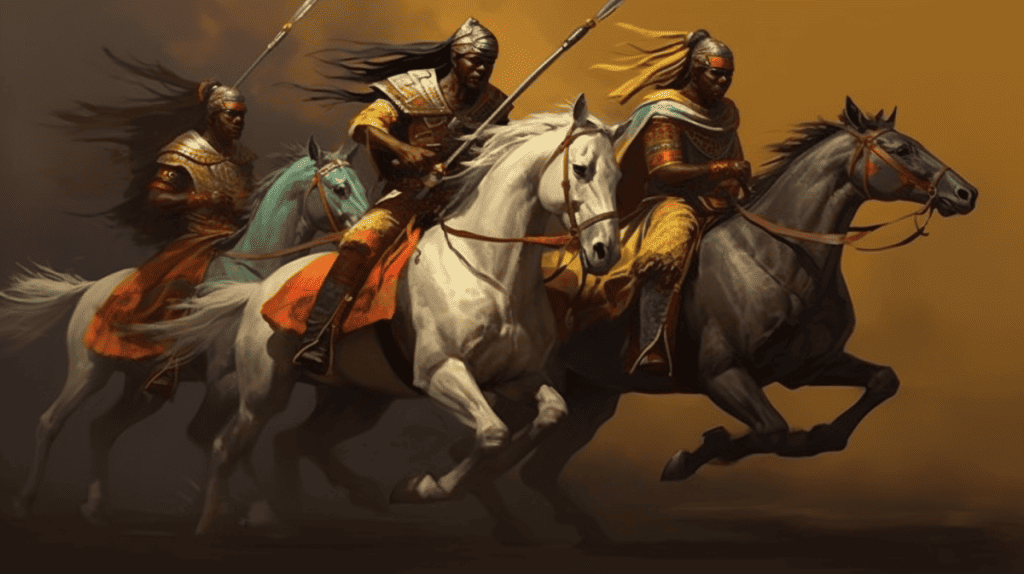
Unburdened by saddles or bridles, Numidian horsemen steered their horses using only a basic rope looped around the animal’s neck. Eschewing the traditional heavy armour and weaponry, they relied on their agility and remarkable horsemanship to compensate. Their only protection was a circular leather shield, while their armaments consisted of a javelin and a small sword. Their ability to nimbly control their horses made them masters of guerrilla tactics, capable of baffling slower, less adaptable armies. Julius Caesar, the famed Roman Emperor, personally experienced this frustration during his campaigns in Africa.
Despite their agility and speed, the Numidians had a notable Achilles heel: their inability to hold their ground against more heavily armoured cavalry without backup. Caesar, having experienced their irksome tactics, responded by deploying heavily armed horsemen who managed to scatter the Numidian ranks. Nevertheless, in smaller conflicts, the Numidian Cavalry provided they had the right support, were peerless in their skills. Hannibal famously utilized the Numidian Cavalry during the Second Punic War, employing their talents to entrap the Romans in cunning ambushes, such as at the Battle of Trebia. The Romans, too, learnt to harness the unique capabilities of the Numidian Cavalry to their advantage.
Under the Numidian Kingdom, the cavalry evolved, incorporating better armour from the Romans but retaining their hallmark mobility.
Even after the dissolution of the Numidian Empire, the indomitable spirit of the Numidian light cavalry continued to gallop through history. The Roman army incorporated these highly skilled riders into their forces, their value so great that they remained irreplaceable for centuries.
Navy & Trade
The Kingdom of Numidia inherited a wealth of prominent Carthaginian ports, which served as significant trade hubs in the Mediterranean. Cicero, the renowned Roman orator and historian, recounted tales of the Numidian king employing a war navy to safeguard his commerce. One anecdote tells of Massinissa’s fleet journeying to Malta, where they seized large ivory elephant pillars from the temple of Juno. Upon returning to Numidia, the coveted pillars were presented to Massinissa as a trophy. However, upon learning the origin of the gift, the king dispatched a swift fleet of five vessels to return the stolen artefacts. This amusing tale not only highlights Massinissa’s maritime capabilities but also reflects his power projection beyond the African coastline, into the heart of the Mediterranean.
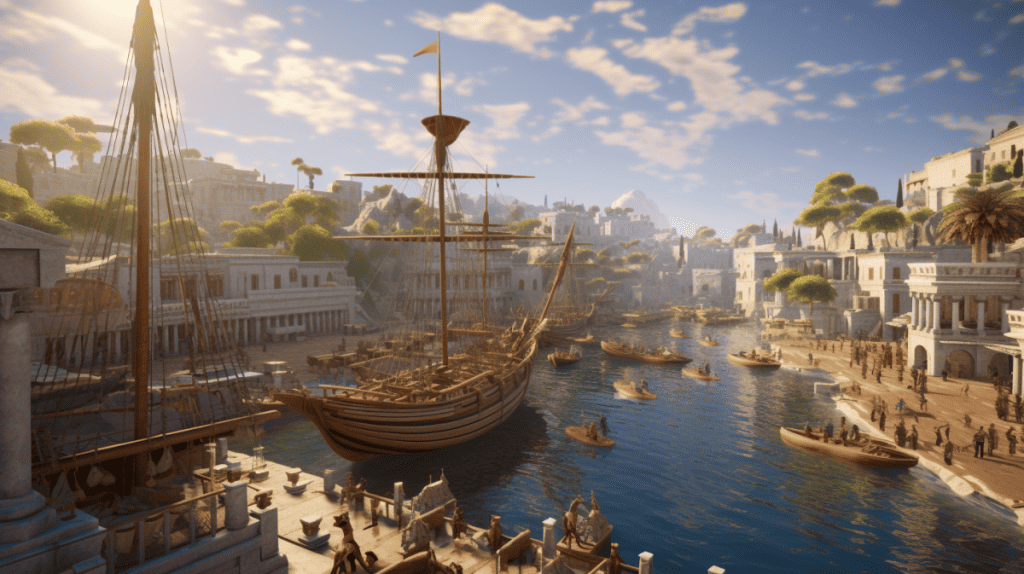
A Rhodean Greek amphora dating back to around 180 B.C., found in the Cirta Museum, serves as a physical testament to Numidia’s expansive trade network. Unlike the Carthaginians, who largely shut off North Africa from Greek commerce, Massinissa welcomed trade interactions with Greek, Egyptian, Syrian, and Italic merchants. He regularly supplied the inhabitants of Rhodes with Toja wood and ivory. Numerous Rhodian amphorae from the 2nd century B.C. have been uncovered in Cirta’s burial sites, with one bearing the inscription (Sodamos), further attesting to the active trade between The Kingdom of Numidia and Rhodes.
Currency
The Numidians boasted a unique currency and minted their own coins, adorned with the image of a charging steed. This iconic symbol served as a proud representation of the famed Numidian cavalry.
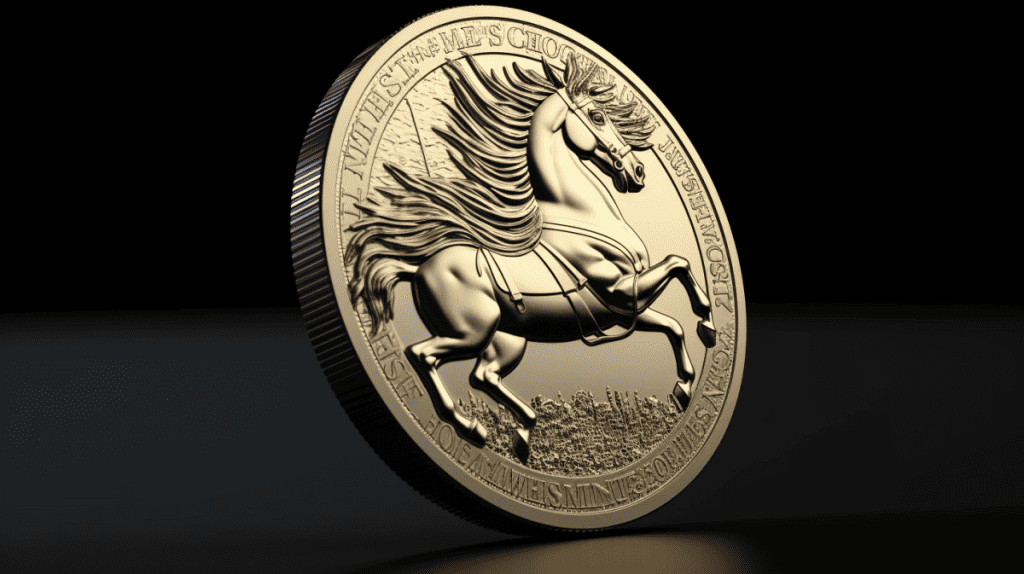
Decline of the Kingdom of Numidia
War with Rome
By 112 BC, Jugurtha reignited his conflict with Adherbal, sparking Rome’s ire when he executed several Roman entrepreneurs aiding his adversary. After a brief clash with Rome, Jugurtha submitted, and a suspiciously lenient peace treaty followed, raising eyebrows and the spectre of bribery. The local Roman commander was called to Rome to answer corruption accusations initiated by his political opponent, Gaius Memmius.
In this swirl of intrigue, Jugurtha was also compelled to journey to Rome, testifying against the Roman commander. However, he faced utter humiliation as his brutal and ruthless history came into sharp focus. Added to this was his suspected role in the murder of a Numidian contender.
Conflict erupted between The Kingdom of Numidia and the Roman Republic, leading to the deployment of multiple legions to North Africa, commanded by the Consul Quintus Caecilius Metellus Numidicus. The war transformed into a seemingly interminable campaign, with Romans struggling to land a decisive blow against Jugurtha.
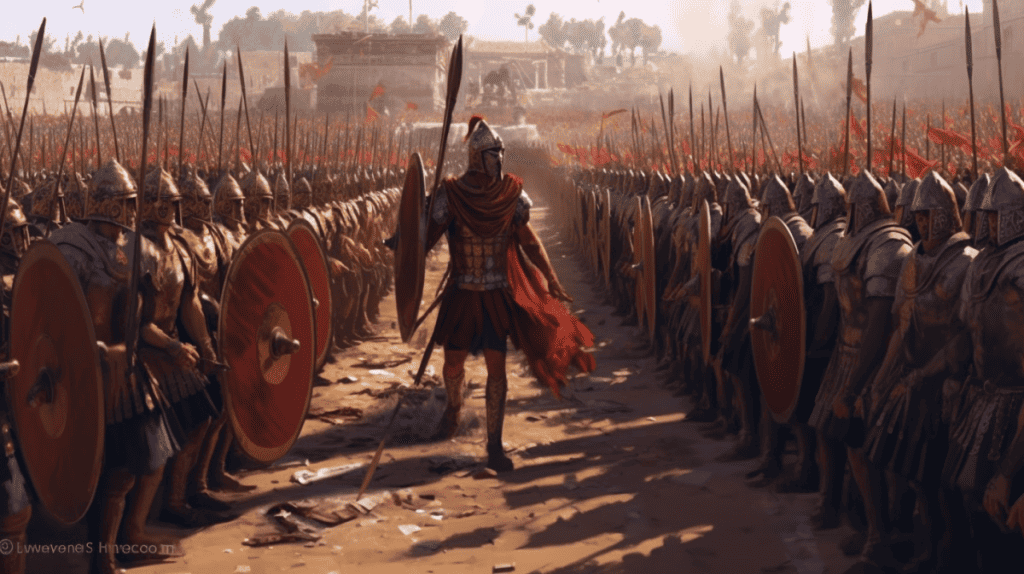
In the face of this sluggish progress, Metellus’ deputy, Gaius Marius, returned to Rome to campaign for the position of Consul. Winning the election, Marius then headed back to Numidia to steer the war effort. He dispatched his Quaestor Sulla to Mauretania to cut off their support for Jugurtha. Assisted by Bocchus I of Mauretania, Sulla apprehended Jugurtha, effectively ending the war. Jugurtha was transported to Rome in chains and imprisoned in the Tullianum.
The ultimate fate of Jugurtha was grim as the Romans executed him in 104 BC, but not before he was paraded through the streets during Gaius Marius’ triumphal procession.
Over the ensuing centuries after falling under Roman conquest, The Kingdom of Numidia would experience the influence of diverse nationalities, until it finally claimed its sovereignty in 1962, emerging as Algeria. The narrative of the Masaesyli is interwoven deeply into its historical tapestry, and the Kingdom of Numidia’s influence reverberates across numerous empires, notably the Kingdom of Mauretania.
Related Posts
Sources
Wikipedia contributors. ‘Numidia.’ Wikipedia, The Free Encyclopedia, last modified July 31, 2023. https://en.wikipedia.org/wiki/Numidia.”
“Think Africa. ‘Kingdom of Numidia: The Berber Kingdom and Rome.’ Think Africa, last accessed July 31, 2023. https://thinkafrica.net/kingdom-of-numidia/#:~:text=The%20Kingdom%20of%20Numidia%20was,of%20around%205000%20square%20miles.”



